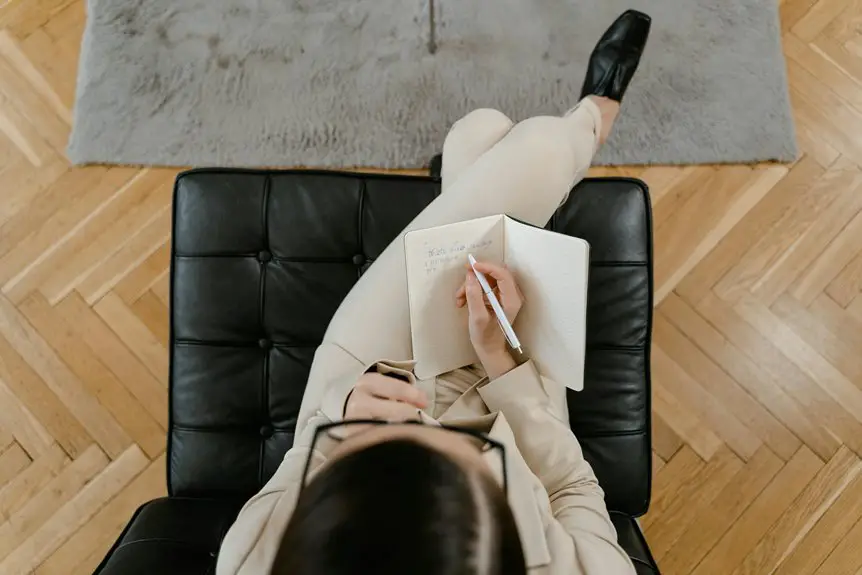Have you ever considered how your chair's back angle affects your comfort and productivity? It's more important than you might think. The right angle can enhance your focus during typing or spark creativity while sketching. Each task demands a different posture. Curious about how to adjust your chair for various activities? Understanding these nuances could transform your daily routine.
Table of Contents
Key Takeaways
- For typing tasks, a chair back angle of 90 to 100 degrees is recommended to promote ergonomic posture and reduce strain.
- When sketching and designing, an angle of 100 to 110 degrees supports the spine's natural curve and encourages creativity.
- During virtual meetings, maintain a chair back angle of 90 to 100 degrees to ensure engagement and proper spine alignment.
- For reading and research, a slightly reclined angle of 100 to 110 degrees reduces neck strain and promotes relaxation.
- Adjust seat height and lumbar support to optimize comfort based on the specific task's recommended chair back angle.
Understanding the Importance of Chair Back Angles
When you sit in a chair, the angle of the backrest plays a crucial role in your comfort and posture. A well-adjusted backrest supports your spine, helping to maintain its natural curve.
If the angle's too upright, you might feel tension in your back; if it's too reclined, you risk slumping. You need to find a balance that allows you to sit comfortably for extended periods.
Proper back angles can also reduce fatigue, enhance focus, and improve productivity. By paying attention to the angle, you promote better blood circulation and decrease the risk of musculoskeletal problems.
Ultimately, understanding the importance of chair back angles empowers you to create a workspace that fosters well-being and efficiency.
Ideal Chair Back Angle for Typing Tasks
The ideal chair back angle for typing tasks typically ranges between 90 to 100 degrees. This angle promotes an ergonomic posture, helping you maintain comfort and reduce strain during long typing sessions. When positioned correctly, your feet should rest flat on the floor, and your elbows should form a 90-degree angle while typing.
Here's a quick comparison of chair angles:
| Angle (Degrees) | Comfort Level | Recommended Duration |
|---|---|---|
| 90 | Moderate | Short sessions |
| 95 | High | 1-2 hours |
| 100 | Very High | 2+ hours |
Choosing the right angle can significantly enhance your typing efficiency and overall productivity. So, adjust your chair for the best results!
Optimal Chair Back Angle for Sketching and Design Work
When you're sketching or working on design projects, the angle of your chair back can significantly impact your comfort and creative flow.
Finding an optimal angle not only supports your back but also helps you maintain focus on your ideas.
Let's explore how the right chair back angle can enhance your creative process.
Ideal Angle for Comfort
Finding the right chair back angle can significantly enhance your comfort during sketching and design work.
Ideally, you should aim for an angle between 100 to 110 degrees. This position allows your spine to maintain its natural curve while providing enough support for your lower back. It also promotes an open hip angle, which can reduce fatigue during long hours of creativity.
Adjust your chair's backrest so you can lean slightly back without losing focus on your work. Don't forget to keep your feet flat on the ground and your knees at a 90-degree angle for added comfort.
With the right angle, you'll be able to concentrate on your designs without discomfort stealing your attention.
Support for Creative Flow
Achieving the ideal back angle not only enhances comfort but also fosters a more productive creative flow.
For sketching and design work, a back angle of around 100 to 110 degrees works wonders. This position encourages an open posture, allowing your ideas to flow freely while keeping your body engaged. You'll find it easier to reach for your tools and make quick adjustments without straining your back or neck.
Consider using a chair with adjustable features, so you can fine-tune your angle as needed.
Recommended Chair Back Angle for Virtual Meetings
The right chair back angle can make a significant difference during virtual meetings. For optimal engagement, aim for a back angle of about 90 to 100 degrees. This position keeps your spine aligned and promotes alertness, helping you stay focused on the discussion.
You'll want to ensure your feet are flat on the ground, providing stability while you interact with your colleagues. In this position, your head should naturally align with your screen, reducing strain on your neck.
Avoid reclining too far back, as it can lead to a more relaxed demeanor that may not convey professionalism. Adjust your chair height, if necessary, to maintain this ideal angle, ensuring you look and feel your best during those crucial virtual interactions.
Best Chair Back Angle for Reading and Research
When you're reading or conducting research, the angle of your chair back can significantly impact your comfort and focus.
Finding the optimal angle helps maintain good posture, allowing you to concentrate better for longer periods.
Let's explore how to adjust your chair for the best reading experience.
Optimal Angle for Reading
While you mightn't realize it, the angle of your chair's back can significantly impact your reading experience. For optimal reading, aim for a back angle between 100 to 110 degrees.
This slightly reclined position allows you to maintain comfort and focus, reducing strain on your neck and eyes. If your chair's back is too upright, you may find it hard to settle into a good reading rhythm, leading to fatigue.
On the other hand, reclining too much can cause difficulty in keeping your book or device at a comfortable level. Experiment with slight adjustments to find your sweet spot, ensuring you can immerse yourself in your reading without distraction.
Proper posture promotes concentration and enjoyment!
Comfort During Research
To ensure comfort during research, it's crucial to find the right back angle for your chair. A back angle between 100 to 110 degrees is often ideal, allowing you to lean slightly back while maintaining engagement with your materials.
This angle supports your lower back and promotes relaxation, which is essential during long study sessions. Adjusting your chair to this position can help reduce fatigue and keep you focused on your work.
Posture and Focus
Finding the best chair back angle for reading and research can significantly enhance your posture and focus. A supportive angle allows you to maintain an upright position, reducing strain and improving concentration. Aim for an angle of about 90 to 100 degrees for optimal results.
Here are three tips to help you adjust your chair:
- Adjust Seat Height: Ensure your feet rest flat on the floor, promoting stability and comfort.
- Use Lumbar Support: A small cushion or built-in lumbar support helps maintain the natural curve of your spine.
- Position Your Screen: If you're using a computer, keep the screen at eye level to avoid leaning forward or backward.
Adjusting Your Chair Back Angle for Breaks and Relaxation
Adjusting your chair back angle for breaks and relaxation can significantly enhance your comfort and overall well-being.
When you take a break, it's essential to lean back and allow your body to unwind. Aim for a reclined angle of about 100 to 110 degrees, which helps reduce pressure on your spine while promoting relaxation. This position also encourages a natural curve in your lower back, alleviating tension.
Don't forget to use a footrest or cushion to support your feet, keeping your legs elevated. This adjustment can improve circulation and further enhance your comfort.
Frequently Asked Questions
How Does Chair Back Angle Affect Overall Posture?
The chair back angle influences your spine's alignment. If it's too upright or too reclined, it can strain your back. Finding the right angle helps you maintain a comfortable posture, reducing fatigue and discomfort throughout the day.
Can Chair Height Influence Back Angle Effectiveness?
Yes, chair height can significantly influence back angle effectiveness. If your chair's too high or low, it can strain your back and hinder proper posture, making it essential to adjust your chair for optimal comfort and support.
What Materials Are Best for Lumbar Support?
When considering lumbar support, foam, gel, and memory foam materials are ideal. They contour to your back, providing comfort and stability. You'll find that these options enhance your posture and reduce discomfort during long sitting periods.
How Often Should I Adjust My Chair Back Angle?
You should adjust your chair back angle regularly, especially when switching tasks. Aim for every 30 to 60 minutes to maintain comfort and support, ensuring your posture remains optimal throughout your activities.
Are There Specific Angles for Gaming Chairs?
Yes, gaming chairs often feature adjustable angles, typically between 90 to 180 degrees. You'll want to find a position that offers comfort and support, enhancing your gaming experience while reducing fatigue during long sessions.




